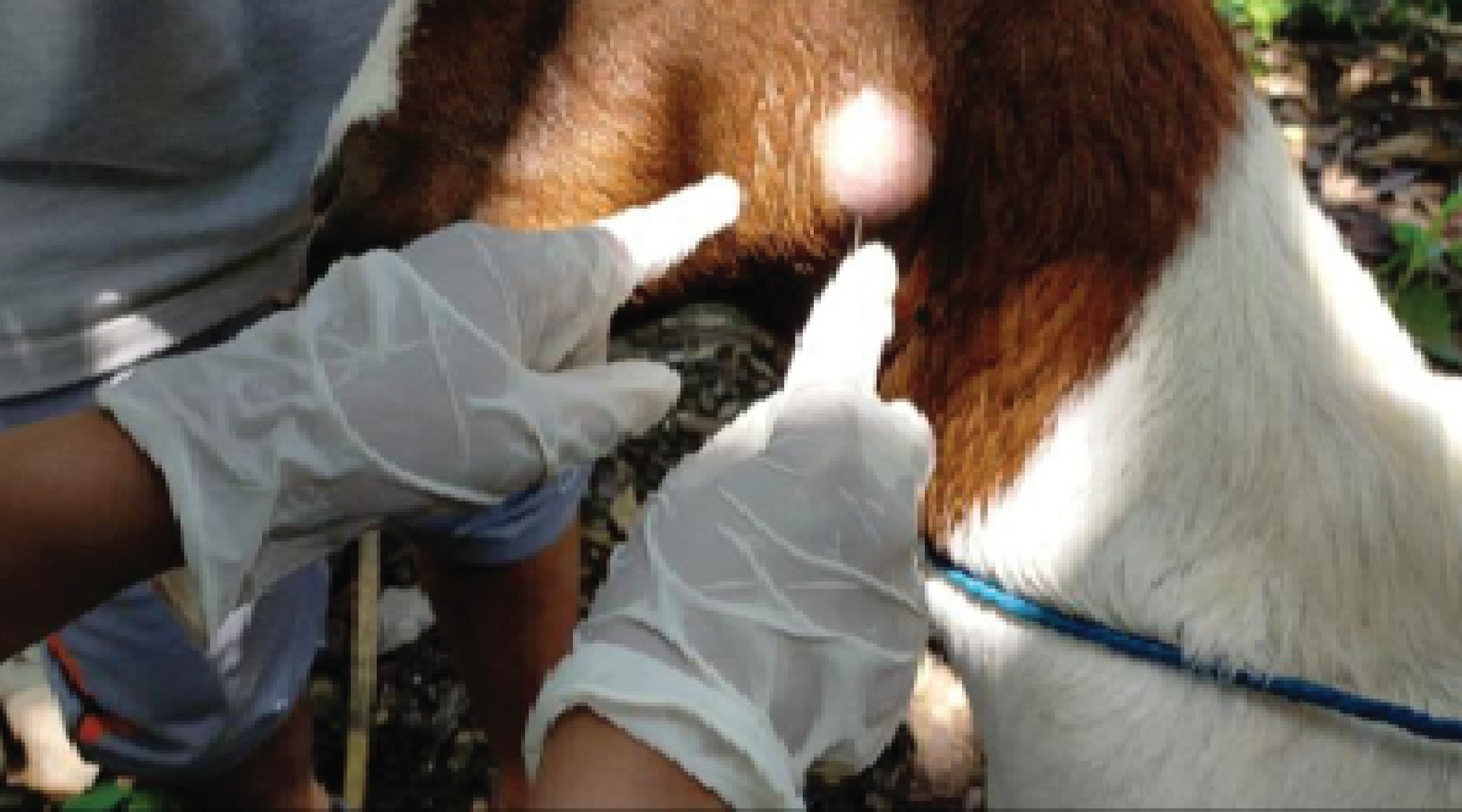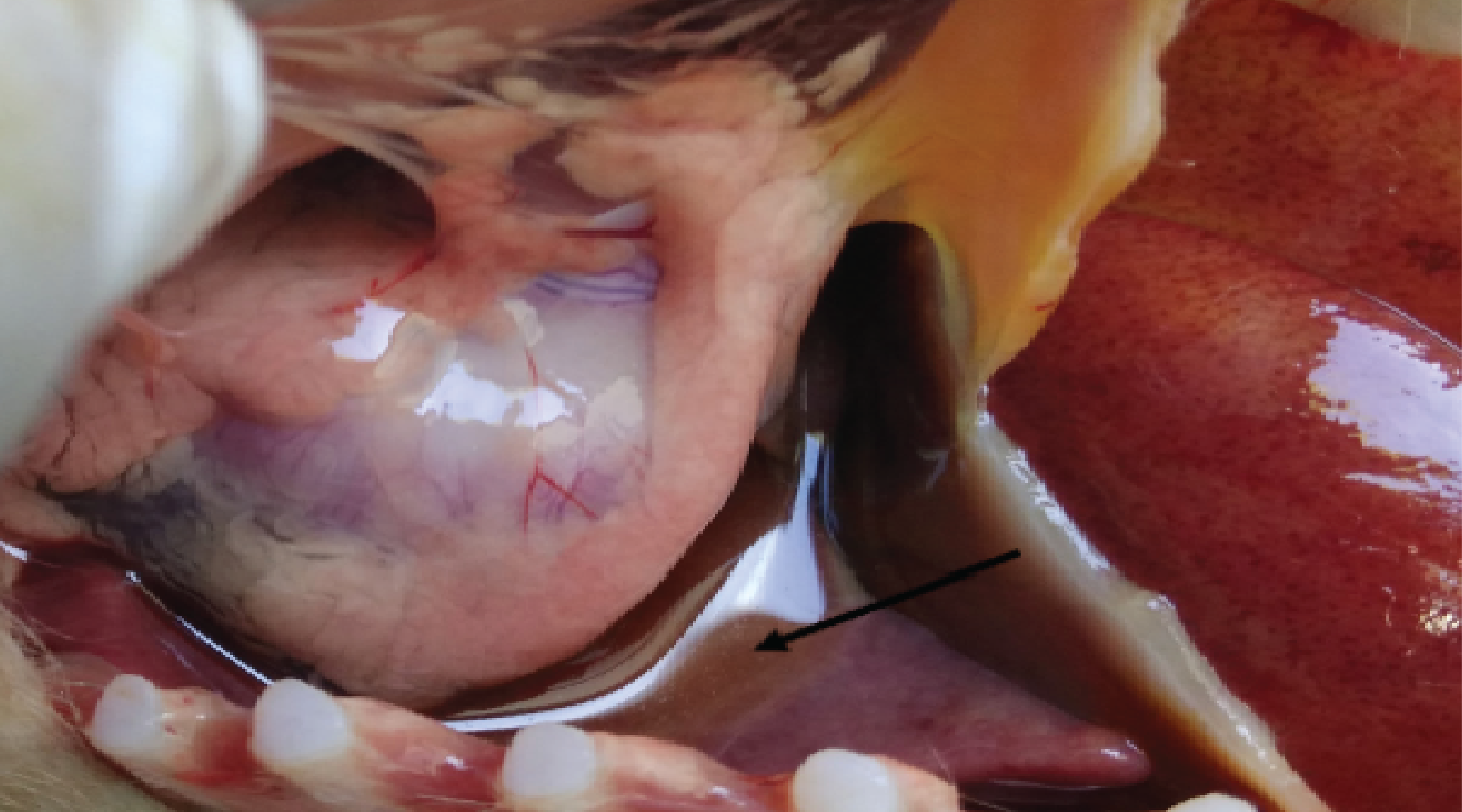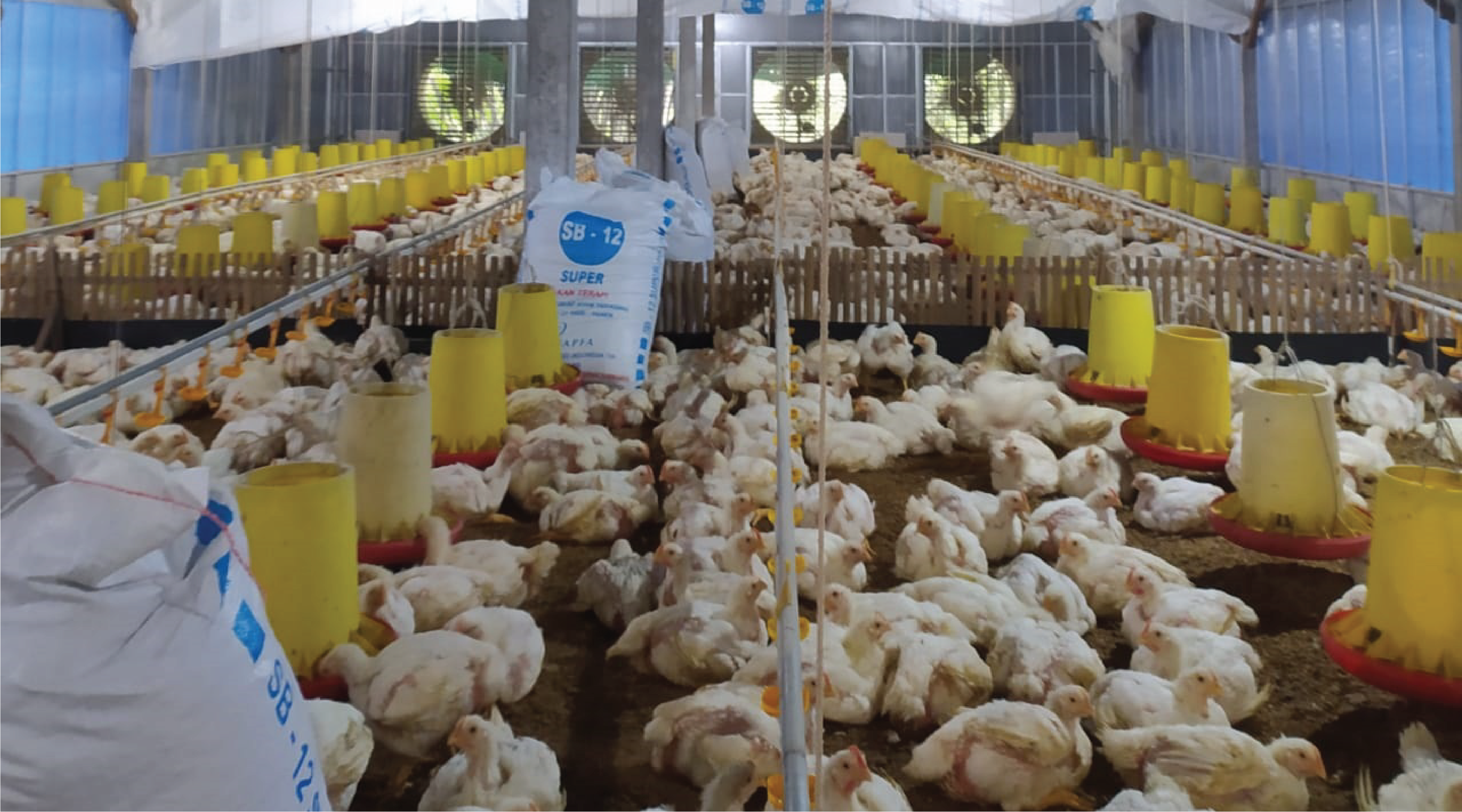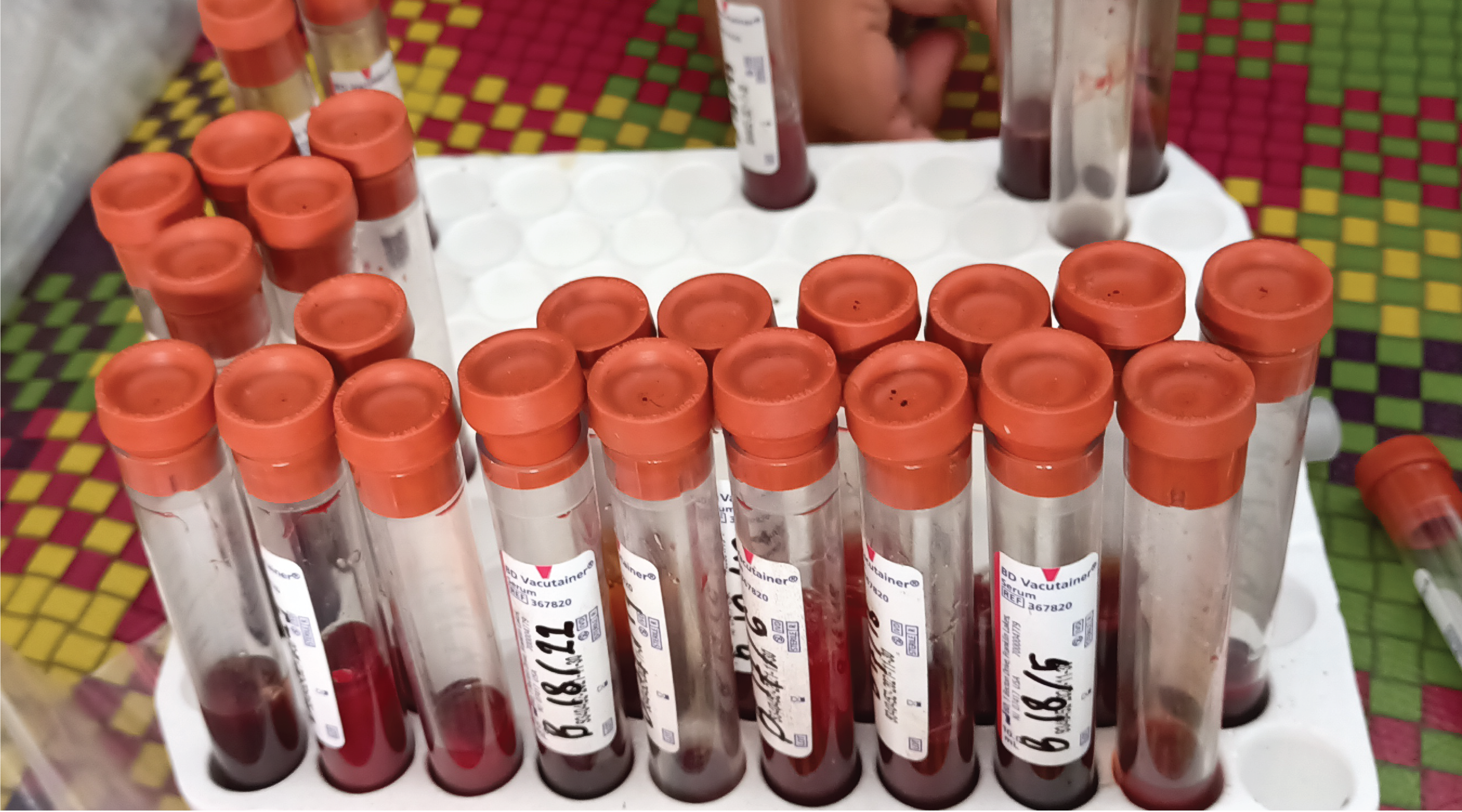Occurrence and Antimicrobial Resistance Profiles of MRSA and ESBL-Producing Enterobacteriaceae in a Veterinary Hospital Environment

Downloads
Background: Nosocomial infections pose a major challenge not only in human hospitals but also in veterinary settings. These infections are frequently associated with methicillin-resistant Staphylococcus aureus (MRSA) and extended-spectrum β-lactamase-producing Enterobacteriaceae (ESBL-E). Purpose: This study aimed to detect and characterize MRSA and ESBL-E isolated from environmental samples at the Veterinary Teaching Hospital, Universitas Brawijaya (VTH UB). Method: The study involved four main procedures: (1) sample isolation; (2) bacterial identification of S. aureus and Enterobacteriaceae using MacConkey agar supplemented with 1 mg/L cefotaxime (MCA + 1 mg/L); (3) antibiotic susceptibility testing and MRSA confirmation using Oxacillin Resistance Screening Agar Base (ORSAB); and (4) confirmation of ESBL production through the Double Disk Synergy Test (DDST). Results: Isolation and identification revealed S. aureus in 86.6% (13/15) of samples and Enterobacteriaceae in 26.6% (4/15). Among Enterobacteriaceae, Klebsiella pneumoniae accounted for 6.7% (1/15) and Enterobacter aerogenes for 20% (3/15). Antimicrobial resistance testing of Staphylococcus aureus isolates showed that all (13/13) were resistant to at least one antibiotic class. Resistance rates were 53.8% (7/13) to oxacillin, 92.3% (12/13) to cefoxitin, 23.0% (3/13) to tetracycline, 92.3% (12/13) to erythromycin, and 46.1% (6/13) to gentamicin. The prevalence of MRSA among environmental isolates was 46.6% (7/15), while ESBL-E prevalence was 26.6% (4/15). Conclusion: The detection of MRSA and ESBL-E in the hospital environment indicates potential zoonotic and hospital associated infection risks in veterinary facilities. These findings emphasize the importance of strengthened infection control practices and provide a baseline for broader surveillance across veterinary hospitals.
Acosta, A.C., Oliveira, P.R.F., Albuquerque, L., Silva, I.F., Medeiros, E.S., Costa, M.M., Junior, J.W.P., and Mota, R.A., 2018. Frequency of Staphylococcus aureus Virulence Genes in Milk of Cows and Goats with Mastitis. Pesquisa Veterinária Brasileira, 38, 2029– 2036.
Adekanmbi, A.O., Akinpelu, M.O., Olaposi, A.V., and Oyelade, A.A., 2021. Extended Spectrum Beta-Lactamase Encoding Gene-Fingerprints in Multidrug Resistant Escherichia coli Isolated from Wastewater and Sludge of A Hospital Treatment Plant in Nigeria. International Journal of Environmental Studies, 78, 140–150.
Afnani, D.A., Fatih, N., Effendi, M.H., Tyasningsih, W., Khairullah, A.R., Kurniawan, S.C., Silaen, O.S.M., Ramandinianto, S.C., Widodo, A., and Riwu, K.H.P., 2022. Profile of Multidrug Resistance and Methicillin-Resistant Staphylococcus Aureus (MRSA) Isolated from Cats in Surabaya, Indonesia. Biodiversitas Journal of Biological Diversity, 23, 5703–5709.
Arafa, A.A., Hedia, R.H., Dorgham, S.M., Ibrahim, E.S., Bakry, M.A., Abdalhamed, A.M., and Abuelnaga, A.S.M., 2022. Determination of Extended-Spectrum β-Lactamase-Producing Klebsiella Pneumoniae Isolated from Horses with Respiratory Manifestation. Veterinary World 15, 827–833.
Bengtsson-Palme, J., Kristiansson, E., and Larsson, D.G.J., 2018. Environmental Factors Influencing The Development and Spread of Antibiotic Resistance. FEMS Microbiology Reviews, 42, 68–80.
Bierowiec, K., Korzeniowska-Kowal, A., Wzorek, A., Rypuła, K., and Gamian, A., 2019. Prevalence of Staphylococcus Species Colonization in Healthy and Sick Cats. BioMed Research International, 1–10.
Biutifasari, V., 2018. Extended Spectrum Beta-Lactamase (ESBL). Oceana Biomedicina Journal. 1, 1–11.
Bolla, N.E., Suarjana, I.G.K., and Gelgel, K.T.P., 2021. Isolasi dan Identifikasi Klebsiella sp. Asal Rongga Hidung Babi Penderita Porcine Respiratory Disease Complex. Indonesia Medicus Veterinus, 10(6), 917–925.
Bujňáková, D., Puvača, N., and Ćirković, I., 2022. Virulence Factors and Antibiotic Resistance of Enterobacterales. Microorganisms, 10, 1588.
Cappuccino, J.G., and Welsh, C.T., 2020. Microbiology: A Laboratory Manual, 12th Edition. Pearson, England.
Cheung, G.Y.C., Bae, J.S., and Otto, M., 2021. Pathogenicity and Virulence of Staphylococcus aureus, Virulence 12(1), 547–569.
Chukwunwejim, C.R., Eze, P.M., Ujam, N.T., Abonyi, I.C., Ejikeugwu, C.P., Abony, D.O., and Esimone, C.O., 2018. Incidence of Community Acquired ESBL-Producing Bacteria among Asymptomatic University Students in Anambra State, Nigeria. European Journal of Biological Research, 8(3), 138–147.
Clinical and Laboratory Standards Institute, 2020. Performance Standards for Antimicrobial Susceptibility Testing. 33rd Edition. Wayne.
Dameanti, F.N.A.E.P., Yanestria, S.M., Effendi, M.H., Plumeriastuti, H., Tyasningsih, W., Ugbo, E.N., Sutrisno, R., and Safri, M.A.A., 2025. Genotyping of Extended-Spectrum Beta-Lactamase-Producing Escherichia Coli Isolated from Wastewater of Dairy Farms in East Java, Indonesia. Veterinary World, 18(1), 162–171.
Dameanti, F.N.A.E.P., Yanestria, S.M., Effendi, M.H., Plumeriastuti, H., Tyasningsih, W., Ugbo, E.N., Sutrisno, R., and Safri, M.A.A.S., 2023a. Identification of BlaSHV and BlaTEM Extended Spectrum Beta-Lactamase Genes in Klebsiella Pneumoniae in The Dairy Wastewater, East Java Province, Indonesia. Biodiversitas Journal of Biological Diversity, 24(11), 6092–6099.
Dameanti, F.N.A.E.P., Yanestria, S.M., Widodo, A., Effendi, M.H., Plumeriastuti, H., Tyasningsih, W., Sutrisno, R., and Akramsyah, M.A., 2023b. Incidence of Escherichia Coli Producing Extended-Spectrum Beta-Lactamasein Wastewater of Dairy Farms in East Java, Indonesia. Biodiversitas Journal of Biological Diversity, 24, 1143–1150.
Davin-Regli, A., and Pagès, J.-M., 2015. Enterobacter Aerogenes and Enterobacter Cloacae; Versatile Bacterial Pathogens Confronting Antibiotic Treatment. Frontiers in Microbiology, 6, 392.
Decline, V., Effendi, M.H., Rahmaniar, R.P., Yanestria, S.M., and Harijani, N., 2020. Profile of Antibiotic-Resistant and Presence of Methicillin-Resistant Staphylococcus Aureus from Nasal Swab of Dogs from Several Animal Clinics in Surabaya, Indonesia. International Journal of One Health, 6, 90–94.
Duin, D.V., and Paterson, D.L., 2020. Multidrug-Resistant Bacteria in The Community: An Update. Infectious Disease Clinics of North America, 34, 709–722.
Dwita, R., Helmi, T.Z., Darmawi, and Hamzah, A., 2018. Isolasi dan Identifikasi Bakteri Gram Negatif Pada Ambing Sapi Aceh. Jurnal Ilmiah Mahasiswa Veteriner, 2(4), 450–459.
Effendi, M.H., and Harijani, N., 2017. Cases of Methicillin-Resistant Staphylococcus Aureus (MRSA) from Raw Milk in East Java, Indonesia. Global Veterinaria, 19(1), 500–503.
Effendi, M.H., Hisyam, M.A.M., Hastutiek, P., and Tyasningsih, W., 2019. Detection of Coagulase Gene in Staphylococcus Aureus from Several Dairy Farms in East Java, Indonesia, by Polymerase Chain Reaction. Veterinary World, 12(1), 68–71.
Feilberg, E., 2015. MRSA in Veterinary Practice and The Need for Infection Control Link Nurses. The Veterinary Nurse, 6(7), 372–379.
Fitranda, M., Salasia, S.I.O., Sianipar, O., Dewananda, D.A., Arjana, A.Z., Aziz, F., Wasissa, M., Lestari, F.B., and Santosa, C.M., 2023. Methicillin-Resistant Staphylococcus Aureus Isolates Derived from Humans and Animals in Yogyakarta, Indonesia. Veterinary World, 16(1), 239–245.
Florida Department of Health, 2020. Guidelines for Prevention and Control of Infection Due to Antibiotic Resistant Organisms (Division of Disease Control & Health Protection Bureau of Epidemiology).
Freeman, J.T., Nimmo, J., Gregory, E., Tiong, A., Almeida, M.D., McAuliffe, G.N., and Roberts, S.A., 2014. Predictors of Hospital Surface Contamination with Extended-Spectrum β-Lactamase-Producing Escherichia Coli and Klebsiella Pneumoniae: Patient and Organism Factors. Antimicrobial Resistance and Infection Control, 3, 5.
Gelalcha, B.D., and Dego, O.K., 2022. Extended-Spectrum Beta-Lactamases Producing Enterobacteriaceae in the USA Dairy Cattle Farms and Implications for Public Health. Antibiotics, 11(10), 1–25.
Ghafourian, S., Sadeghifard, N., Soheili, S., and Sekawi, Z., 2015. Extended Spectrum Beta-Lactamases: Definition, Classification and Epidemiology. Current Issues in Molecular Biology, 17, 11–21.
Ghenea, A.E., Zlatian, O.M., Cristea, O.M., Ungureanu, A., Mititelu, R.R., Balasoiu, A.T., Vasile, C.M., Salan, A.-I., Iliuta, D., Popescu, M., Udriștoiu, A.-L., and Balasoiu, M., 2022. TEM,CTX-M,SHV Genes in ESBL-Producing Escherichia Coli and Klebsiella Pneumoniae Isolated from Clinical Samples in a County Clinical Emergency Hospital Romania-Predominance of CTX-M-15. Antibiotics, 11, 1–12.
Giudice, P.D., 2020. Skin Infections Caused by Staphylococcus Aureus. Acta Dermato Venereologica, 100, adv00110-215.
Hoet, A.E., Johnson, A., Nava-Hoet, R.C., Bateman, S., Hillier, A., Dyce, J., Gebreyes, W.A., and Wittum, T.E., 2011. Environmental Methicillin-Resistant Staphylococcus Aureus in A Veterinary Teaching Hospital during A Nonoutbreak Period. Vector Borne and Zoonotic Diseases, 11, 609–615.
Hounmanou, Y.M.G., Bortolaia, V., Dang, S.T.T., Truong, D., Olsen, J.E., Dalsgaard, A., 2021. ESBL and AmpC β-Lactamase Encoding Genes in E. Coli from Pig and Pig Farm Workers in Vietnam and Their Association with Mobile Genetic Elements. Frontiers in Microbiology, 12, 629139.
Huang, Y.-H., Kuan, N.-L., and Yeh, K.-S., 2020. Characteristics of Extended-Spectrum β-Lactamase–Producing Escherichia Coli from Dogs and Cats Admitted to A Veterinary Teaching Hospital in Taipei, Taiwan from 2014 to 2017. Frontiers in Veterinary Science, 7, 1–9.
Imasari, T., Tyasningsih, W., Wasito, E.B., and Kuntaman, 2018. Prevalensi dan Pola Gen Extended Spectrum B-lactamase Bakteri Usus Sapi Perah dan Penduduk Sekitar Peternakan di Surabaya. Jurnal Veteriner, 19, 313–320.
Khairullah, A.R., Raharjo, D., Rahmahani, J., Suwarno, Tyasningsih, W., and Harijani, N., 2019. Antibiotics Resistant at Staphylococcus Aureus and Streptococcus Sp Isolated from Bovine Mastitis in Karangploso, East Java, Indonesia. Indian Journal of Forensic Medicine & Toxicology, 13, 439–444.
Khairullah, A.R., Ramandinianto, S.C., and Effendi, M.H., 2020. A Review of Livestock-Associated Methicillin-Resistant Staphylococcus Aureus (LA-MRSA) on Bovine Mastitis. Systematic Reviews in Pharmacy, 11, 172–183.
Khairullah, A.R., Sudjarwo, S.A., Effendi, M.H., Ramandinianto, S.C., Gelolodo, M.A., Widodo, A., Riwu, K.H.P., Kurniawati, D.A., and Rehman, S., 2022. Profile of Multidrug Resistance and Methicillin-Resistant Staphylococcus Aureus (MRSA) on Dairy Cows and Risk Factors from Farmer. Biodiversitas Journal of Biological Diversity, 23, 2853–2858.
Khasanah, R.N., Puspitasari, I., Nuryastuti, T., and Yuniarti, N., 2020. Prevalensi Multidrug-Resistant Klebsiella Pneumonia dan Evaluasi Kesesuaian Antibiotik Empiris Berdasarkan Nilai Prediksi Farmakokinetik terhadap Outcome Klinis di RSUP Dr Soeradji Tirtonegoro Klaten. Majalah Farmaseutik, 16(1), 27–33.
Khatoon, H., Anokhe, A., and Kalia, V., 2022. Catalase Test: A Biochemical Protocol for Bacterial Identification. AgriCos e-Newsletter, 3, 53–55.
Kong, C., Chee, C.-F., Richter, K., Thomas, N., Rahman, N.Abd., and Nathan, S., 2018. Suppression of Staphylococcus Aureus Biofilm Formation and Virulence by A Benzimidazole Derivative, UM-C162. Scientific Reports, 8, 2758.
Kristianingtyas, L., Effendi, M.H., Witaningrum, A.M., Wardhana, D.K., and Ugbo, E.N., 2021. Prevalence of Extended-Spectrum β-Lactamase-Producing Escherichia Coli in Companion Dogs in Animal Clinics, Surabaya, Indonesia. International Journal of One Health, 7, 232–236.
Kunhikannan, S., Thomas, C.J., Franks, A.E., Mahadevaiah, S., Kumar, S., and Petrovski, S., 2021. Environmental Hotspots for Antibiotic Resistance Genes. MicrobiologyOpen, 10, e1197.
Lakhundi, S., and Zhang, K., 2018. Methicillin-Resistant Staphylococcus aureus: Molecular Characterization, Evolution, and Epidemiology. Clinical Microbiology Reviews, 31, e00020-18.
Larasati, S.A., Windria, S., and Cahyadi, A.I., 2020. Kajian Pustaka: Faktor-Faktor Virulensi Staphylococcus Aureus yang Berperan Penting dalam Kejadian Mastitis Pada Sapi Perah. Indonesia Medicus Veterinus, 9(6), 1022–1037.
Larsson, D.G.J., and Flach, C.-F., 2022. Antibiotic Resistance in The Environment. Nature Reviews Microbiology, 20, 257–269.
Lee, A.S., Lencastre, H.D., Garau, J., Kluytmans, J., Malhotra-Kumar, S., Peschel, A., and Harbarth, S., 2018. Methicillin-Resistant Staphylococcus Aureus. Nature Reviews Disease Primers 4, 18033.
Loeffler, A., Pfeiffer, D.U., Lloyd, D.H., Smith, H., Soares-Magalhaes, R., and Lindsay, J.A., 2010. Meticillin-Resistant Staphylococcus Aureus Carriage in UK Veterinary Staff and Owners of Infected Pets: New Risk Groups. Journal of Hospital Infection, 74, 282–288.
Lohr, B., Pfeifer, Y., Heudorf, U., Rangger, C., Norris, D.E., and Hunfeld, K.-P., 2018. High Prevalence of Multidrug-Resistant Bacteria in Libyan War Casualties Admitted to A Tertiary Care Hospital, Germany. Microbial Drug Resistance, 24, 578–584.
Marami, L.M., Berhanu, G., Tekle, M., Agga, G.E., Beyene, T.J., Tufa, T.B., Beyi, A.F., and Edao, B.M., 2022. Antimicrobial Resistance of Staphylococci at Animal Human Interface in Smallholders and Dairy Farms in Central Oromia, Ethiopia. Infection and Drug Resistance 15, 3767–3777.
Maulana, K.Y., Pichpol, D., Farhani, N.R., Widiasih, D.A., Unger, F., Punyapornwithaya, V., and Meeyam, T., 2021. Antimicrobial Resistance Characteristics of Extended Spectrum Beta Lactamase (ESBL) - Producing Escherichia Coli from Dairy Farms in The Sleman District of Yogyakarta Province, Indonesia. Veterinary Integrative Sciences, 19, 525–535.
Morgado, S., Fonseca, É., Freitas, F., Caldart, R., Vicente, A.C., 2024. In-Depth Analysis of Klebsiella Aerogenes Resistome, Virulome and Plasmidome Worldwide. Scientific Reports, 14, 6538.
Müller-Schulte, E., Tuo, M.N., Akoua-Koffi, C., Schaumburg, F., and Becker, S.L., 2020. High Prevalence of ESBL - Producing Klebsiella Pneumoniae in Clinical Samples from Central Côte D’Ivoire. International Journal of Infectious Diseases, 91, 207–209.
Nahar, A., Islam, A.K.M.A., Islam, Md.N., Khan, M.K., Khan, Md.S., Rahman, A.K.M.A., and Alam, Md.M., 2023. Molecular Characterization and Antibiotic Resistance Profile of ESBL - Producing Escherichia Coli Isolated from Healthy Cow Raw Milk in Smallholder Dairy Farms in Bangladesh. Veterinary World, 16(6), 1333–1339.
Okwu, M.U., Olley, M., Akpoka, A.O., and Izevbuwa, O.E., 2019. Methicillin-Resistant Staphylococcus Aureus (MRSA) and Anti-MRSA Activities of Extracts of Some Medicinal Plants: A Brief Review. AIMS Microbiology, 5(2), 117–137.
Patel, K.K., and Patel, S., 2016. Enterobacter Spp.: - An Emerging Nosocomial Infection. International Journal of Applied Research, 2, 532–538.
Pumipuntu, N., Kulpeanprasit, S., Santajit, S., Tunyong, W., Kong-ngoen, T., Hinthong, W., and Indrawattana, N., 2017. Screening Method for Staphylococcus Aureus Identification in Subclinical Bovine Mastitis from Sairy Farms. Veterinary World, 10(7), 721–726.
Ramandinianto, S.C., Khairullah, A.R., Effendi, M.H., and Hestiana, E.P., 2020. Profile of Multidrug Resistance (MDR) and Methicillin Resistant Staphylococcus Aureus (MRSA) on Dairy Farms in East Java Province, Indonesia. Indian Journal of Forensic Medicine & Toxicology 14(4), 3440–3445.
Ruple‐Czerniak, A.A., Aceto, H.W., Bender, J.B., Paradis, M.R., Shaw, S.P., Van Metre, D.C., Weese, J.S., Wilson, D.A., Wilson, J., and Morley, P.S., 2014. Syndromic Surveillance for Evaluating The Occurrence of Healthcare‐Associated Infections in Equine Hospitals. Equine Veterinary Journal, 46, 435–440.
Saekhow, P., and Sriphannam, C., 2021. Prevalence of Extended-Spectrum Beta-Lactamase-Producing Escherichia Coli Strains in Dairy Farm Wastewater in Chiang Mai. Veterinary Integrative Sciences, 19(3), 349–362.
Schnitt, A., and Tenhagen, B.-A., 2020. Risk Factors for The Occurrence of Methicillin-Resistant Staphylococcus Aureus in Dairy Herds: An Update. Foodborne Pathogens and Disease, 17, 585–596.
Sebola, D.C., Oguttu, J.W., Kock, M.M., and Qekwana, D.N., 2023. Hospital-Acquired and Zoonotic Bacteria from A Veterinary Hospital and Their Associated Antimicrobial-Susceptibility Profiles: A Systematic Review. Frontiers in Veterinary Science, 9, 1087052.
Sfaciotte, R.A.P., Leandro, P., Karine, P., and Maria, S.F., 2023. Nosocomial Infection in Veterinary Medicine: A Rare Event or Neglected by Veterinarians?. International Journal of Zoology and Animal Biology, 6, 1–15.
Suardana, I.W., Dinarini, N.M.A.A., and Sukrama, I.D.M., 2021. Identifikasi Spesies Streptokokus β-Hemolisis Hasil Isolasi dari Nasal dan Tonsil Babi dengan Uji Basitrasin. Buletin Veteriner Udayana, 13(1), 27–33.
Sun, D., Jeannot, K., Xiao, Y., and Knapp, C.W., 2019. Editorial: Horizontal Gene Transfer Mediated Bacterial Antibiotic Resistance. Frontiers in Microbiology, 10, 1933.
Walther, B., Tedin, K., and Lübke-Becker, A., 2017. Multidrug-Resistant Opportunistic Pathogens Challenging Veterinary Infection Control. Veterinary Microbiology, 200, 71–78.
Waruwu, Y.K.K., Khairullah, A.R., Effendi, M.H., Lukiswanto, B.S., Afnani, D.A., Kurniawan, S.C., Silaen, O.S.M., Riwu, K.H.P., Widodo, A., and Ramandinianto, S.C., 2023. Detection of Methicillin-Resistant Staphylococcus Aureus and Multidrug Resistance Isolated from Cats in Animal Clinic at Sidoarjo District, East Java, Indonesia. Biodiversitas Journal of Biological Diversity 24, 106–111.
Widodo, A., Effendi, M.H., and Khairullah, A.R., 2020. Extended-Spectrum Beta-Lactamase (ESBL)-Producing Eschericia Coli from Livestock. Systematic Reviews in Pharmacy, 11, 382–392.
Zhang, H., Gao, Y., and Chang, W., 2016. Comparison of Extended-Spectrum β-Lactamase-Producing Escherichia Coli Isolates from Drinking Well Water and Pit Latrine Wastewater in A Rural Area of China. BioMed Research International, 2016, 1–7.
Copyright (c) 2025 Authors

This work is licensed under a Creative Commons Attribution-ShareAlike 4.0 International License.
- The journal allows the author to hold the copyright of the article without restrictions.
- The journal allows the author(s) to retain publishing rights without restrictions.
- The legal formal aspect of journal publication accessibility refers to Creative Commons Attribution Share-Alike (CC BY-SA).

Journal of Applied Veterinary Science and Technology is licensed under a Creative Commons Attribution-ShareAlike 4.0 International License





























